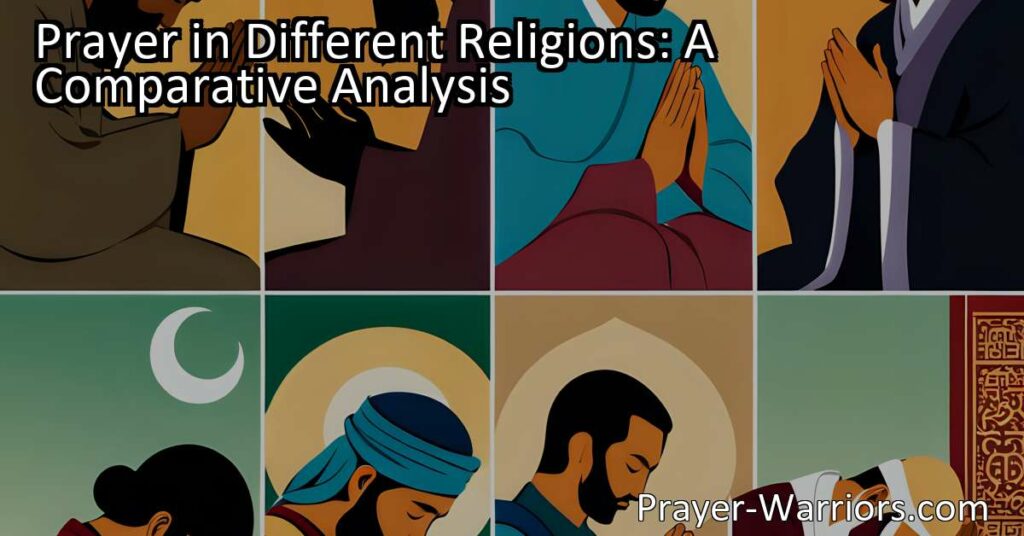In this comparative analysis, we explore how prayer is understood and practiced in Christianity, Islam, and Buddhism. While each religion approaches prayer differently, it serves as a means of seeking guidance, expressing gratitude, and finding solace. Whether through individual or communal prayer, believers worldwide find meaning and connection through this powerful practice in their respective religious traditions.
Table of Contents
Prayer in Different Religions: A Comparative Analysis
Prayer in Different Religions: A Comparative Analysis
Prayer is a significant aspect of religious practices around the world. It serves as a way to connect with a higher power, seek guidance, express gratitude, and find solace. While the concept of prayer may seem universal, the ways in which different religions approach and practice prayer vary greatly. In this comparative analysis, we will explore how prayer is understood and practiced in three major world religions Christianity, Islam, and Buddhism.
Christianity, one of the largest religions globally, places great importance on prayer. For Christians, prayer is seen as a direct line of communication with God. It is believed that through prayer, believers can seek forgiveness, request guidance, express thanks, and find comfort. Christians often pray individually, at any time and place, but there is also a strong emphasis on communal prayer during worship services. In Christian prayer, it is common for individuals to bow their heads, close their eyes, and fold their hands as a sign of reverence and focus. They may use scripted prayers, such as the Lord’s Prayer, or offer personal, spontaneous prayers.
Islam, the second-largest religion in the world, views prayer as one of the Five Pillars, which are essential acts of faith. Muslims are expected to pray five times a day, facing the Kaaba in Mecca, as directed by the Qur’an. This form of prayer, known as Salah, is a structured, ritualized practice involving specific movements and recitations. Muslims begin their prayers by performing ablution, a cleansing ritual, to purify themselves before engaging in communication with Allah. During Salah, Muslims stand, bow, prostrate, and sit in a specific sequence while reciting verses from the Qur’an in Arabic. The prayers are performed at specific times of the day, such as dawn, midday, afternoon, sunset, and evening, fostering a consistent connection with God throughout the day.
Buddhism, often considered a philosophy rather than a religion, approaches prayer in a unique way. Buddhists do not see prayer as a means of connecting with a higher power but rather as a way to cultivate inner qualities, such as compassion and mindfulness. Prayer in Buddhism is identified as meditation or mindfulness practice. Buddhists focus their attention inward, using various techniques like breath awareness or visualizations to attain mental clarity and achieve a deep state of calmness. While rituals and prayers may differ across Buddhist traditions, the purpose remains the same to achieve a state of enlightenment and liberation from suffering.
When exploring prayer in different religions, we can see both similarities and differences. Regardless of the religious tradition, prayer serves as a means to seek guidance, express gratitude, and find solace. However, the methods and rituals involved in prayer vary significantly.
Comparing these three religions, we see that Christianity emphasizes a personal and direct connection with God, allowing for individualized and spontaneous prayer, while Islam focuses on regular and structured communal prayer as a fundamental aspect of religious practice. Buddhism, on the other hand, approaches prayer as a form of meditation, focusing on individual enlightenment and inner transformation.
Despite these differences, prayer plays a crucial role in fostering a sense of spirituality and connection within these religious communities. It provides individuals with a space to reflect, seek guidance, and find comfort. Prayer also unifies believers in a shared experience and creates a sense of community, whether through personal prayer or communal worship.
Prayer in different religions offers a fascinating insight into the diverse ways in which humans seek spiritual connection. Christianity, Islam, and Buddhism each approach and practice prayer distinctively, with Christianity emphasizing individual communication with God, Islam emphasizing structured communal prayer, and Buddhism viewing prayer as a means of inner transformation. Despite these differences, prayer continues to be a powerful and meaningful practice across religious traditions, providing solace, guidance, and a sense of community to believers worldwide.
I hope this prayer inspired image brings you hope and peace. Share it with someone who needs it today!


